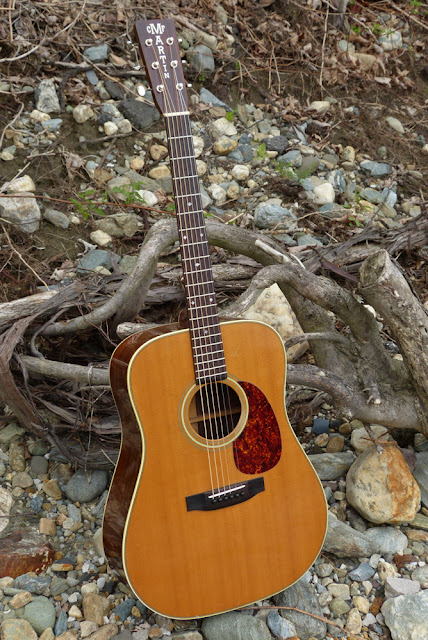1989 Martin Shenandoah HD-2832 Dreadnought Guitar
First-off: this is a nice old dreadnought. It flatpicks beautifully and has a crisp, punchy, big old sound.
The history of Martin's Shenandoah line can get pretty confused in online discussions. Simply put, Martin had a factory in Japan make bodies and necks (solid top, lam back/sides) and then brought them to the Martin factory for fitting of the neck, the spray job, pickguard, and final adjustments and setup. The end result was a good-quality Japanese-made instrument (think nicer Daions and Tamas) with the attention to detail in the neck-set and finishing-side of American-made Martins. It also bears a "Made in USA" stamp on the interior that fudges-over the round-the-world approach, but is "fair enough."
This particular model is an HD-28 from the series (hence HD-2832 -- the 32 specifying a Shenandoah guitar) of "regular line" copies (others are D-1832, etc.) which specifies the old-fashioned "herringbone" purfling around the top edge and the "lined diamond" inlay in the fretboard. It's got a solid spruce top and laminate rosewood back and sides. The board and bridge are both rosewood as well and, as you may have noticed, the headstock veneer was switched. More on that in a bit.
My work included a fret level/dress, new compensated bone saddle, installation of replacement tuners, yanking-out of an undersaddle pickup system (Fishman) that had clunky controls sapping tone mounted at the soundhole, new ebony bridge pins, and general setup. It's strung with a set of lights, basically, that has the B&E bulked up to 17/13 and the action is 3/32" E&A and 1/16" DGB&E at the 12th fret -- spot-on.
At a glance (or even the first few look-overs), I wouldn't think this was anything else than a D-28 with some cosmetic enhancements. The finish is "standard Martin" and looks grand. It's been played, played, played but shows mostly minor/average pickwear and usewear save on the neck where the finish has been worn quite a bit (in an endearing way).
The headstock veneer was redone in the old Martin script pattern from the 30s at some point by a famous inlay fellow up here in Vermont.
The last owner told me that when he got the guitar someone had scratched-out the "Shenandoah" bit of the headstock decal and so he had this made for it. Let's face it -- that's handsome!
The frets are good to go and have lots of life left. The nut is a standard 1 11/16" and the scale is Martin's standard "25.4" long scale. The back of the neck has a mostly-C, bit-of-V, 60s-ish sort of profile to it. It's comfortable and fast but not quite as slim as the modern "low profile" feel. Basically -- the guitar "feels" quality -- and won't disappoint someone looking for something that's a bit of D-18 and D-28 at a lower price-point.
It's hard to argue with herringbone.
Yanking-out the undersaddle pickup and going to a straight connection with a new bone saddle helped the volume and punch quite a bit (both of which this has in spades). I also went to ebony pins for a more classic look.
Despite being lam, the rosewood is awfully pretty.
I replaced the heavy, clunky sealed tuners with these Kluson-style repros which lightened the headstock, give a more vintage look, and work just as well.
The headstock has the cool diamond "volute," and while many of the Shenandoah necks were "nato" wood, this one looks like regular mahogany to me.
This wear-through runs up the edge of the bass side, too. Someone loved playing this guitar, dearly.
There's a small bit of finish funk at the waist/shoulder area on the "knee" side, as you can see. It's nothing that I wouldn't expect of any old Martin.
The truss works as it should, the neck is straight, and the serial matches with other Martin serials for easy look-up.
The endpin jack now serves simply as a strap button. In this day and age, undersaddle pickups and their batteries and clumsy on-board preamps sound like dinosaurs to me, when better and cheaper pickup systems are available. The guitar enjoyed having all that crud "clipped" right out of it.
An old Martin molded case (with only two functional latches and some outside damage -- though good enough) comes with it. Also -- note that in this photo you can see some of those scritchy-scratch marks on the upper bout a lot better. There's three longer ones on the bass side of the soundhole.


























Comments